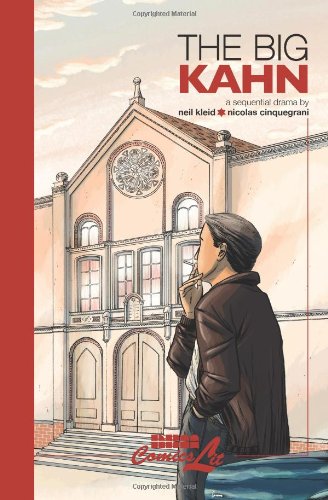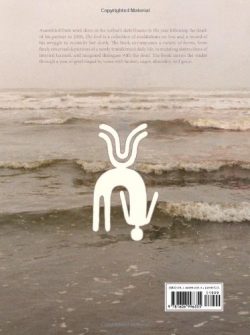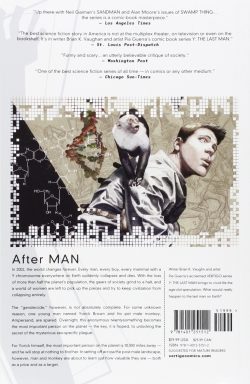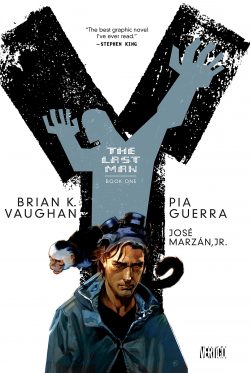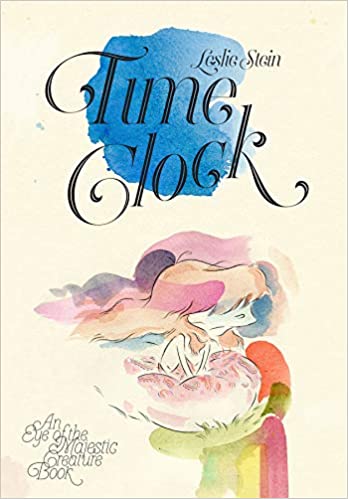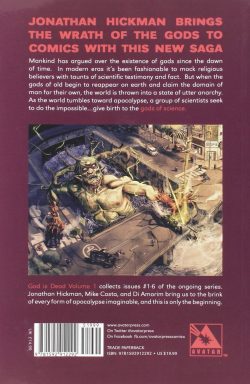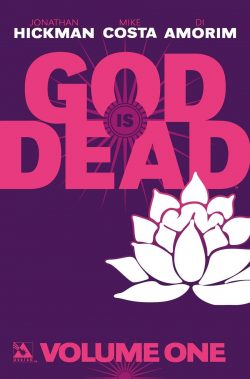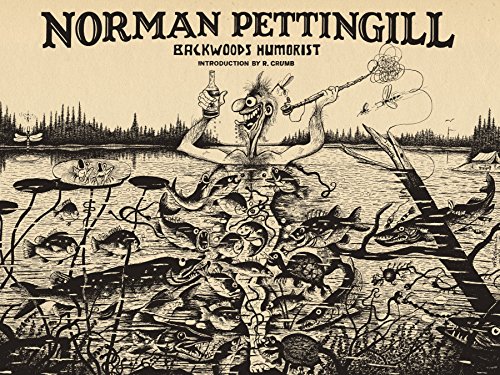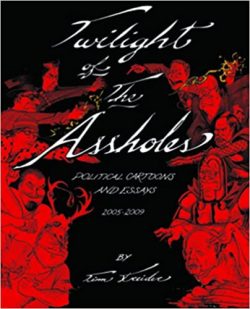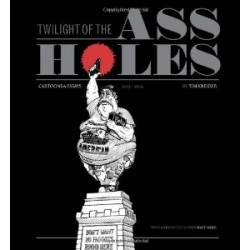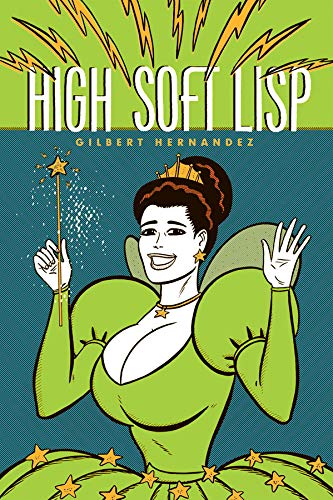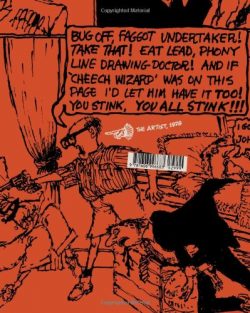
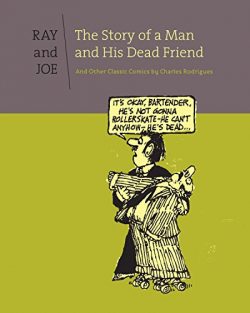
By Charles Rodrigues, Bob Fingerman & Gary Groth (Fantagraphics Books)
ISBN: 978-1-60699-668-3(HB)
Charles Rodrigues (1926-2004) is arguably one of the most influential – and certainly most darkly hilarious – American cartoonists of the last century.
His surreal, absurd, insane, anarchic, socially disruptive and utterly unforgettable bad-taste doodles were delivered with electric vitality and galvanising energetic ferocity in a number of magazines. He was most effective in Playboy, The National Lampoon (from its debut issue) and Stereo Review: the pinnacle of a cartooning career which began after WWII and spanned almost the entire latter half of the 20th century.
After leaving the Navy and relinquishing the idea of writing for a living, Rodrigues used his slice of the G.I. Bill provision to attend New York’s Cartoonists and Illustrator’s School (now the School of Visual Arts). In 1950, he began schlepping gags around the low-rent but healthily ubiquitous “Men’s Magazine†circuit and found a natural home. He gradually graduated from those glorified girly-mags to more salubrious publications and in 1954 began a lengthy association with Hugh Hefner in a revolutionary new venture even while still contributing to what seemed like every publication in the nation buying panel gags, from Esquire to TV Guide, Genesis to The Critic.
Rodrigues even found time to create three strips for the Chicago Tribune-New York News Syndicate: Eggs Benedict, Casey the Cop and Charlie.
Despite such legitimacies though, the quiet, genteel devout Catholic’s lasting monument is the wealth of truly gob-smacking, sick, subversive, offensive and mordantly, trenchantly wonderful strip-series he crafted for The National Lampoon. Editor Henry Beard sought him out in the earliest pre-launch days of 1969, and offered Rodrigues carte blanche, complete creative freedom and a regular full-page spot. He stayed with the prestigious mag from the 1970 debut until 1993, a mainstay of its legendary comics section…
In this superbly appalling hardback or digital tome – bracketed by informative text pieces ‘Introduction: An Appreciation of a Goddamn Great Cartoonist’ and ‘Biography: Charles Rodrigues’ by passionate devotee Bob Fingerman – the parade of diabolical disgust and fetid fun begins with the eponymous ‘Ray and Joe – the Story of a Man and his Dead Friend’ which follows the frankly disturbing buddy-movie path of Joe – whose death doesn’t upset his wife as much as you’d expect. In fact, when the cadaver’s former pal meekly inquires, she’s more than happy to let Ray keep the body. After all, it’s cheaper than a funeral…
There’s no agenda here: Ray just wants to keep his friend around, even going so far as to have him embalmed and put on roller skates. Of course, most people simply don’t understand…
Rodrigues regularly broke all the rules in these strips: taste, decency, even the contract between reader and creator. Often, he would drop a storyline and return to his notional continuities at a later date. Sometimes he would even stop mid-episode and insert a new strip or gag if it offered bigger chortles or shocks…
Next up is ‘Deirdre Callahan – a biography’: the gut-wrenching travails of a little girl so ugly she could cause people’s eyeballs to explode and make almost everyone she met kill themselves in disgust. Of course such a pitiful case – the little lass with a face “too hideous for publication†– did elicit the concern of many upstanding citizens: ambitious plastic surgeons, shyster lawyers, radical terrorists, enemy agents, bored, sadistic billionaires in need of a good laugh, the mother who threw her in a garbage can before fully examining the merchandising opportunities…
The artist’s most long-lived and inspired creation was ‘The Aesop Brothers – Siamese Twins’, which ran intermittently from the early 1970s to 1986 in an unceasing parade of grotesque situations where conjoined George and Alex endured the vicissitudes of a life forever together: the perennial problems of bathroom breaks, getting laid, enjoying a little “me timeâ€â€¦
In the course of their cartoon careers the boys ran away to the circus to be with a set of hot conjoined sisters, but that quickly went bits-up, after which sinister carnival owner Captain Menshevik had them exhibited as a brother/sister act with poor Alex kitted out in drag.
There’s a frantic escapade with a nymphomaniac octogenarian movie goddess, assorted asshole doctors, Howard Hughes’ darkest secret, a publicity-shy rogue cop, marriage (but only for one of them), their horrendous early lives uncovered, the allure of communism, multiple choice strips, experimental, existential and faux-foreign episodes, and even their outrageous times as Edwardian consulting detectives.
This is not your regular comedy fare and there’s certainly something here to make you blanch, no matter how jaded, strong-stomached or dissolute you think you are…
As always with Rodrigues, even though the world at large hilariously exploits and punishes his protagonists, it’s not all one-sided. Said stars are usually dim and venal and their own worst enemies too…
Hard on their four heels comes the saga of ‘Sam DeGroot – the Free World’s Only Private Detective in an Iron Lung Machine’: a plucky unfortunate determined to make an honest contribution, hampered more by society’s prejudices than his own condition and ineptitude…
After brushes with the mob and conniving billionaires’ wives, no wonder he took to demon drink. Happily, Sam was saved by kindly Good Samaritan Everett, but the gentle giant then force-fed him custard and other treats because he was a patient urban cannibal. Thankfully, that’s when Jesus enters the picture…
During the course of these instalments, the strip was frequently usurped by short guerrilla gag feature ‘True Tales of the Urinary Tract’ and only reached its noxious peak after Sam fell into a coma…
The artist was blessed – or, perhaps, cursed – with a perpetually percolating imagination which drove him to craft scandalously inaccurate Biographies. Included here are choice and outrageous insights into ‘Marilyn Monroe’, ‘Abbie Hoffman’, ‘Chester Bouvier’, ‘Eugene O’Neill’ and ‘Jerry Brown’ as well as ‘An American Story – a Saga of Ordinary People Just Like You’, ‘The Man Without a County’ and ‘Joe Marshall Recalls his Past’…
The horrific and hilarious assault on common decency concludes with a selection of shorter series collected as The Son of a Bitch et al, beginning with an exposé of that self-same American institution.
‘The Son of a Bitch‘ leads into the incontinent lives of those winos outside ’22 Houston Street’, the ongoing calamity of ‘Doctor Colon’s Monster’, the domestic trauma of ‘Mama’s Boy’ and the sad fate of ‘The “Cuckold‒…
‘The Adventures of the United States Weather Bureau starring Walter T. Eccleston’ is followed by ‘Mafia Tales’ and ‘VD Clinic Vignettes’, after which ‘A Glass of Beer with Stanley Cyganiewicz of Scranton, PA’ goes down smoothly, thanks to the then-contentious Gay question addressed in ‘Lillehammer Follies’, before everything settles down after the recipe for ‘Everett’s Custard’…
Fantagraphics Books yet again struck gold by reviving and celebrating a lost hero of graphic narrative arts in this superb commemoration of a mighty talent. This is an astoundingly funny collection, brilliantly rendered by a master craftsman and one no connoisseur of black comedy can afford to miss; especially in times when we all feel helpless and can only laugh in the face of incompetence, venality, stupidity and death…
All strips and comics by Rodrigues © Lorraine Rodrigues. Introduction & Biography © Bob Fingerman. All rights reserved. This edition © 2011 Fantagraphics Books.

